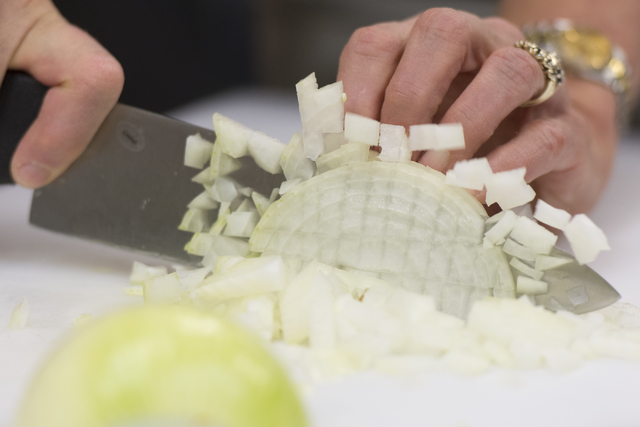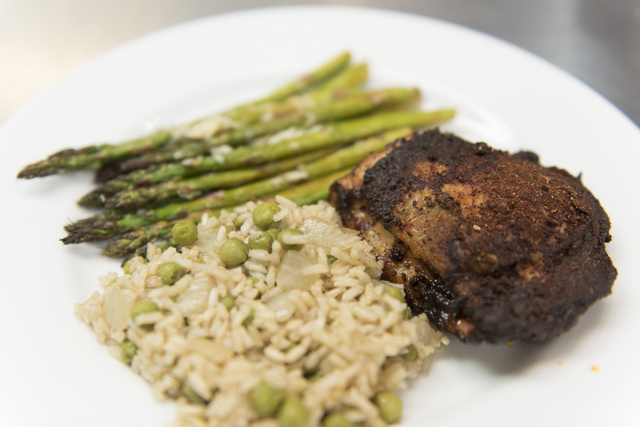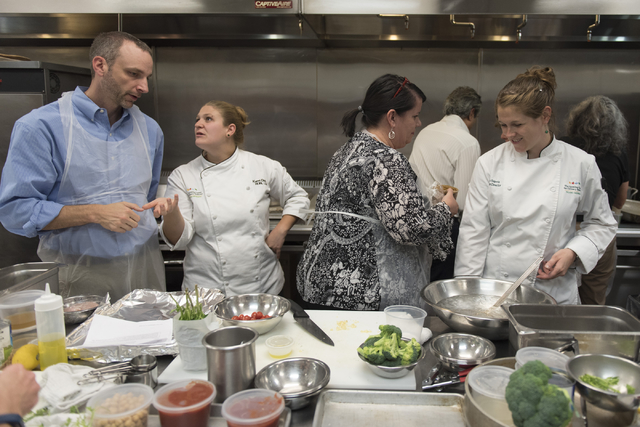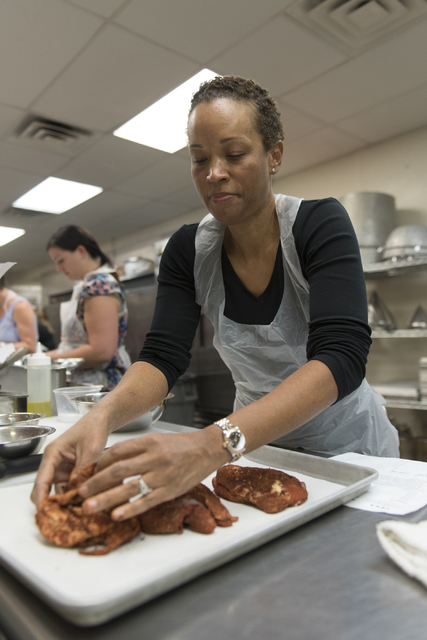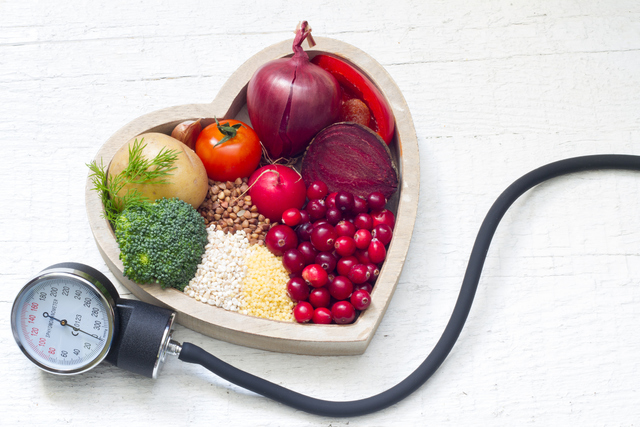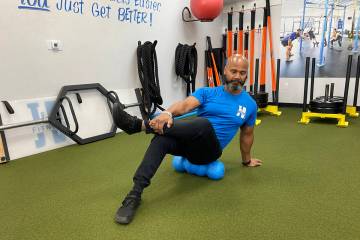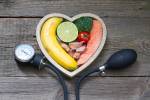Medical professionals take to the kitchen to help patients eat healthy
The aromas wafting in the air — of chickens roasting in the oven and vinegar destined for a tangy salad dressing and a dozen spices being artfully added to a dozen dishes — and the determined hustle of the cooks responsible for it all are what you’d expect to experience in a professional kitchen.
What’s unexpected here are the cooks: Several physicians, a psychotherapist, a few nurses, a pharmacist and other health care professionals participating in a hands-on, forks-up lesson in how easy and how tasty healthy eating can be.
All are attendees of a Cardiometabolic Risk Summit held recently at Caesars Palace, and overseeing this in-kitchen seminar is Dr. Timothy Harlan, executive director of the Goldring Center for Culinary Medicine at Tulane University (www.culinarymedicine.org) and a practicing internal medicine physician.
In his guise as “Dr. Gourmet,” Harlan also is a lecturer and author (“Just Tell Me What to Eat! The Delicious 6-week Weight Loss Plan for the Real World”) who, through his website (www.drgourmet.com) offers medical professionals and laymen guidance, references and recipes about nutrition and cooking.
Harlan says teaching patients about food — what to eat, how to cook it, how to tweak what they’re already eating to make it a bit healthier — isn’t something most physicians are trained to do. While a doctor might, for example, advise a patient in the examination room to lose weight, a physician generally won’t go beyond that by evaluating a patient’s eating habits or offering practical alternatives.
As a result, a patient might embark on a fad diet that may work at first but can’t be sustained over time. In teaching medical students and physicians, Harlan says the idea is “taking that basic science information they learn in medical school and then train them into having the conversation you’re going to have with your patients about food in the examination room.”
“It’s not about diet, and it’s certainly not about weight loss,” Harlan adds. “Weight loss is important to us, but the other half of the dialogue that never gets talked about is the quality of (food) that we consume, because the data are pretty clear that our patients are going to be very challenged about losing weight.”
At this particular session at the Culinary Academy of Las Vegas, the health professionals-turned-cooks are preparing dishes based upon principles of the Mediterranean diet, which, according to Harlan, has been the focus of “maybe three times as many good-quality studies as the next-closest diet schema.”
More importantly, he says, the principles upon which the Mediterranean diet is built easily can be applied to the dishes home cooks already are making at home.
“We take Mediterranean diet principles, which are pretty straightforward,” Harlan says. “More fruits and nuts. More vegetables. More whole grains. More legumes; we love legumes. More fish, but less fish than you’d think. Quality fats and oils and a good balance of those. Less dairy, but not no dairy. Less meat, but not no meat, just leaner meat. And alcohol in moderation.
“If you think about those principles, those are tacos, spaghetti, red beans and rice, macaroni and cheese. So we take Mediterranean diet principles and translate them to the American kitchen.”
For example, “if you think of tacos, what are tacos? Tacos are corn tortillas,” Harlan says. “Corn is a whole grain. That’s one point on your Mediterranean diet. You’re gonna fill it with, maybe, lean meat. Fish is better. Or beans, legumes — we love legumes — fish or veggies.”
“Then, the thing we teach people is to stop eating ultra-processed food and to cook for themselves,” Harlan says. “I don’t want you, necessarily, to give up red meat. I want you to eat less of it and to be sensible about it and to eat less processed food.”
Harlan says adopting principles of the Mediterranean diet can help to stave off cardiovascular disease, “and if you can improve your Mediterranean diet score by two points, you can reduce your all-cause mortality by 25 percent. And that’s all-cause, that’s not just the heart, and that’s irrespective of weight loss.”
Harlan’s work includes teaching medical students about how to discuss diet and nutrition with patients.
“Our medical students, we call them force multipliers because we teach our medical students, they teach the community and we’re making healthy medical students,” he says. “And we believe in the long run … that they’re better physicians and are able to counsel their patients on diet.”
For this seminar, the health professionals design a menu incorporating Mediterranean diet principles and cook the dishes themselves. Then, their dishes, and other students’ dishes, are enjoyed during a dinner together.
Already, the students have studied Mediterranean diet principles and have learned about fad diets and how to discuss them with patients.
“Our message with these is, your patient is going to eat better if they do a fad diet than they probably are now,” Harlan says “So you go on the Atkins diet and you’re probably going to stop (eating) Cheez-its and drinking 7-Up. You’re probably going to be more cognizant of your diet and you will lose some weight and almost certainly be healthier.”
“The problem is, most of them are not sustainable,” Harlan continues.The goal is, instead, to offer patients evidence-based alternatives that “meets them where they live.”
The student cooks begin with instruction in basic kitchen techniques — safety, how to chop an onion safely, the importance of measuring ingredients to keep calories and fats within limits. Then, they go to work for the next hour as Harlan walks the room, peppering students with compliments for their work.
Anna Testa, a public health nurse from Salt Lake City, says one of her takeaways is the importance of measuring oils. “ ‘Oh, it’s olive oil. It’s good for you,’” she says. “But not when you’re sprinkling it like mother did.”
Dr. Andrew Vaughan, a cardiologist from Charleston, West Virginia, says his goal is learning how to educate patients about what they cook and what they eat to help reduce their risk of heart disease and stroke and high blood pressure
Dr. Mary Dickson, an occupational medicine physician from Monument, Colorado, says nutrition is “so much a part of people getting better.” Dickson says that, in her own practice, she works with truck drivers who struggle with hypertension, sleep apnea and often-limited food choices on the road.
Saundra Jain, a psychotherapist from Austin, Texas, says that “there are very solid data that food choices are connected to health, and not just physical health but mental health. So this is interesting.”
Nick Wilkins, a clinical pharmacist from Charlotte, North Carolina, says he sees a lot of diabetes among his patients, and that diet is key to managing the condition. In fact, he says, “we see people actually get off their medication when they change the way they eat.”
At dinner, the students present their dishes, offering a rundown of nutritional values and techniques they’ve used — roasting to kick start the taste of umami, using spices and herbs instead of salt — to improve their dishes while pumping up the dishes’ flavor.
There’s a chicken stew. A pasta dish with roasted tomatoes and Parmesan cheese. Moroccan chicken with roasted asparagus and basmati rice with peas. Even chicken masala, featuring chickpeas.
The memory of the meal will be good, but the information the professionals take with them can help to improve the health of their patients.
It’s not about dieting, Harlan says. “If I can just get you to change the quality of the calories you’re eating, you can improve your health really dramatically and with not a lot of work.”
Read more from John Przybys at reviewjournal.com. Contact him at jprzybys@reviewjournal.com and follow @JJPrzybys on Twitter.




